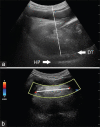Utilization of submandibular ultrasound in assessing upper airway changes following the administration of propofol
- PMID: 38269166
- PMCID: PMC10805214
- DOI: 10.4103/joacp.joacp_113_22
Utilization of submandibular ultrasound in assessing upper airway changes following the administration of propofol
Abstract
Background and aims: Our study aimed to use submandibular ultrasound to measure upper airway parameters before and after induction dose of propofol in order to further understand upper airway changes that occur during induction of anesthesia. Measuring the changes that occur in airway anatomy due to the hypotonic effects of induction agents will allow for a deeper understanding of airway management.
Material and methods: We enrolled 39 patients between November 2021 and January 2022. Submandibular ultrasound was used to measure tongue thickness, geniohyoid muscle thickness, the distance between the lingual arteries (DLA), lateral pharyngeal wall thickness, and hyomental distance before and after administration of induction doses of the commonly used, sedative-hypnotic agent, propofol.
Results: The mean DLA increased significantly after propofol administration, from 3.62 ± 0.63 cm to 3.79 ± 0.56 cm (P < 0.001). The mean tongue thickness was 4.89 ± 0.51 cm and decreased significantly to a mean of 4.62 ± 0.50 cm after propofol administration (P < 0.001). The change in DLA measurements after propofol administration decreased significantly as STOP-BANG score increased (r = -0.344, P = 0.037). However, DLA measurements when patients were awake increased significantly with an increase in the STOP-BANG score (r = 0.351, P = 0.031).
Conclusion: These findings suggest that propofol widens and flattens the tongue, which are changes that may contribute to difficult airway management. Given the quick and non-invasive nature of ultrasound, further studies should evaluate the role of submandibular ultrasound for understanding the upper airway and airway management in various populations.
Keywords: Airway management; airway obstruction; anesthesia; propofol; ultrasonography.
Copyright: © 2022 Journal of Anaesthesiology Clinical Pharmacology.
Conflict of interest statement
There are no conflicts of interest.
Figures
Similar articles
-
Magnetic resonance imaging of the upper airway. Effects of propofol anesthesia and nasal continuous positive airway pressure in humans.Anesthesiology. 1996 Feb;84(2):273-9. doi: 10.1097/00000542-199602000-00004. Anesthesiology. 1996. PMID: 8602656 Clinical Trial.
-
Utilization of submandibular ultrasound to measure oral cavity changes with interventions in routine airway management.Proc (Bayl Univ Med Cent). 2021 Sep 28;35(1):20-23. doi: 10.1080/08998280.2021.1980318. eCollection 2022. Proc (Bayl Univ Med Cent). 2021. PMID: 34970025 Free PMC article.
-
Upper-airway collapsibility and compensatory responses under moderate sedation with ketamine, dexmedetomidine, and propofol in healthy volunteers.Physiol Rep. 2020 May;8(10):e14439. doi: 10.14814/phy2.14439. Physiol Rep. 2020. PMID: 32441458 Free PMC article. Clinical Trial.
-
Diagnostic Performance of Airway Ultrasound for the Assessment of Difficult Laryngoscopy: A Systematic Review and Meta-Analysis.J Cardiothorac Vasc Anesth. 2023 Jul;37(7):1101-1109. doi: 10.1053/j.jvca.2023.02.036. Epub 2023 Mar 2. J Cardiothorac Vasc Anesth. 2023. PMID: 37012134
-
Propofol anesthesia.Vet Clin North Am Small Anim Pract. 1999 May;29(3):747-78. doi: 10.1016/s0195-5616(99)50059-4. Vet Clin North Am Small Anim Pract. 1999. PMID: 10332821 Review.
Cited by
-
Evaluation of ultrasound measured tongue thickness, tongue thickness-thyromental distance ratio, and skin-to-epiglottis distance in predicting unanticipated difficult laryngoscopy.J Anaesthesiol Clin Pharmacol. 2025 Jan-Mar;41(1):151-157. doi: 10.4103/joacp.joacp_423_23. Epub 2025 Jan 23. J Anaesthesiol Clin Pharmacol. 2025. PMID: 40026745 Free PMC article.
References
-
- Austin DR, Chang MG, Bittner EA. Use of handheld point-of-care ultrasound in emergency airway management. Chest. 2021;159:1155–65. - PubMed
-
- Byrne M, Singleton M, Kalagara H, Haskins SC. Perioperative point-of-care ultrasound. Adv Anesth. 2021;39:189–213. - PubMed
-
- Abuan MRA, Lin WN, Hsin LJ, Lee LA, Fang TJ, Chen NH, et al. Tongue imaging during drug-induced sleep ultrasound in obstructive sleep apnea patients. Auris Nasus Larynx. 2020;47:828–36. - PubMed
-
- Huang YC, Hsu YB, Lan MY, Yang MC, Kao MC, Huang TT, et al. Dynamic tongue base thickness measured by drug-induced sleep ultrasonography in patients with obstructive sleep apnea. J Formos Med Assoc. 2021;120:354–60. - PubMed
LinkOut - more resources
Full Text Sources

